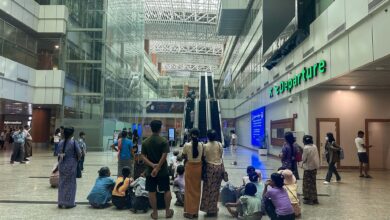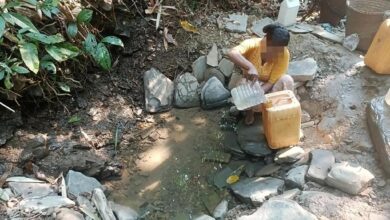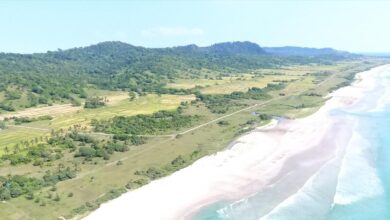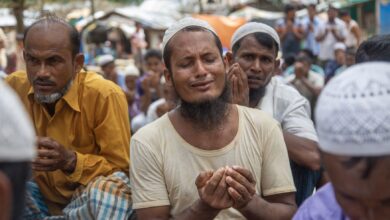
A drone hovers over a Myanmar junta base before dropping a bomb on a target below. A camera attached to the drone captures the moment of detonation, and the video goes viral, demonstrating the effectiveness of a weapon that has become an indispensable part of the resistance arsenal.
Few took the anti-regime National Unity Government (NUG) seriously when it announced in September 2021 that it had formed an “air force”. Since then, however, it has become clear that the resistance does, indeed, have the capacity to rain down terror on its enemies, even if not on the scale of a military equipped with attack helicopters and fighter jets.
Forced to fight their revolution on a shoestring, junta opponents have deployed not only combat drones, but also amateur-use drones, to great effect. Normally used for aerial photography, these smaller, simpler-to-use devices can be fitted with explosives capable of doing real damage.
For Saw Naga, the leader of the Saw Dragon Drone Force, an armed resistance group operating in southern Myanmar, the value of the drones is not limited to their ability to take out their intended targets.
“Every soldier and officer is constantly afraid now of bombs dropping out of the sky. They all have stiff necks from always having to look up every few seconds,” he laughs.

One of the problems with the smaller drones is that they lack precision when delivering their payload. But according to Htet Myat, a former army captain now taking part in the Civil Disobedience Movement (CDM), this doesn’t really matter, because a drone attack doesn’t have to make a direct hit in order to be considered successful.
“If we can manage to drop a bomb every single day, that’s good enough. That will force them to worry about the attacks yet to come and wear them down mentally. In a way, it’s a form of psychological warfare,” he explained.
Even Min Aung Hlaing, Myanmar’s top general and junta leader, has warned about underestimating the threat posed by drones. In a leaked internal memo dated August 30, he is quoted as saying that extra vigilance is needed to safeguard against drone attacks.
Three weeks later, the regime announced at a press conference that it had started installing signal jammers and anti-drone weapons at several military bases.

‘A very troubling threat’
But instilling fear in junta troops is not the only purpose of drones. In some areas, such as parts of Sagaing Region and Karen (Kayin) State, larger combat drones have been used to deadlier effect.
In a statement released on October 1, Federal Wings—the NUG’s name for its nascent air force—claimed that it had killed a total of 48 regime personnel in 89 drone strikes carried out in Karen State’s Waw Lay, Kyainseikgyi and Kawkareik townships.
Many People’s Defence Force (PDF) groups—some under the command of the NUG, others operating more autonomously—have adopted drones in their fight against the regime. According to some observers, they have actually begun to approximate a real air force.
“It’s debatable whether they could really go up against jets, but there is no doubt that the PDF’s use of drones has proven to be a very troubling threat for the military,” said Salai Thant Zin, a veteran journalist who has closely followed the conflict triggered by last year’s military coup.

But the resistance is not alone in using drones. The military has also made extensive use of them, mostly for scouting purposes. More recently, however, it has begun to mimic the tactics of resistance forces by attaching bombs to cheap camera drones.
So far, the only recorded instance of this use of drones by the military has been in Duu Yin Pin Shaung, a village near the town of Palaw in Tanintharyi Region, where on October 13, three explosives were dropped on a security checkpoint set up by the Karen People’s Defence Force-Palaw. The group later reported that three of its members were injured in the attack.
Htet Myat, the CDM army captain, warned that such attacks could become more common in the future. He also suggested that there was a real danger the regime would find ways to exploit the resistance’s reliance on drones.
“Their drones could lock a target on our drones, track them, and drop bombs on our bases,” he said.
The indispensable weapon
As drones become an increasingly important part of the armed struggle against the regime, many anti-junta forces have dedicated a great deal of time and effort to mastering their use and adapting them to their purposes.
According to Tun Gyi, a PDF spokesperson, one of the greatest challenges that the resistance faced when it started using drones was simply learning how to calculate the effect of the wind when dropping bombs.
“It was difficult at first to hit targets on the ground because we had to take the wind into consideration. But our aim has gotten much better with time. We can now calculate and drop bombs more accurately,” he said.
Some groups have even taught themselves how to more effectively weaponise small, commercial drones by modifying them in ways that enable them to carry 80mm missiles or more than one explosive.

One group, the T.G.R Women’s Drone Force in Sagaing Region’s Myaung Township, is an all-female unit that both makes bombs and pilots the specially-built drones that drop them on junta bases and pro-regime forces.
The military, which has lost a number of high-ranking officers to such attacks, has been paying close attention to these developments, according to Htet Myat.
“The military has teams of people that can recognise the different parts of the drones. They are always coming up with ways to take them down. So we have to be careful to prevent the enemy from finding out what kinds of weapons we are using,” he said.
As the conflict that began with the overthrow of Myanmar’s civilian government drags one, the regime has become even more indiscriminate in its killing of civilians, including children, through airstrikes and other forms of excessive force.
For Saw Naga, the leader of the Saw Dragon Drone Force, this means that efforts must be redoubled to bring the revolution to a quick and successful conclusion. And to achieve that goal, he says, drones will be the indispensable weapon.
“Our drones will be flying day and night over their heads, their towns and their bases.”



